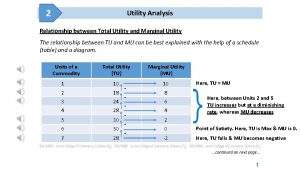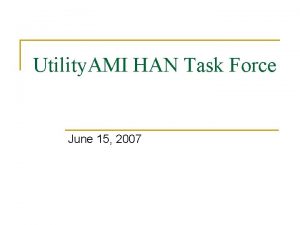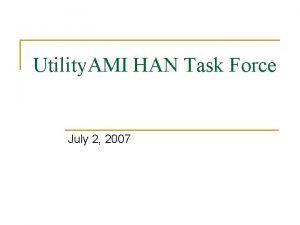AMI Enterprise Task Force of the Utility AMI






- Slides: 6

AMI Enterprise Task Force of the Utility AMI Working Group SRS Team Status Report (Palo Alto, Jan. 09) Joe Zhou #1

SRS Team Status • SRS team status since the Knoxville meeting: – Developed first complete draft of the Logical Components and Functions Model – Supported AMI-ENT service definition team activities including the CMS-AEP collaboration meeting – Started to develop the first draft of the SRS document • Guiding Principles • Reference Architecture • Requirements – Goal is to make the first draft available for reviews by the March meeting. #2

AMI-ENT SRS Table of Content 1. Introduction 1. 1 Purpose 1. 2 Scope 1. 3 Acronyms and Abbreviations 1. 4 External Considerations and References 1. 5 Document Overview 2. Overall Description 2. 1 Architecture Guiding Principles 2. 2 Architectural Considerations 3. AMI-ENT Reference Architecture 3. 1 AMI-ENT Reference Model 3. 2 AMI-ENT Logical Architecture 4. AMI-ENT System Requirements 4. 1 Requirements Framework 4. 2 Systems Requirements Specification 4· 2. 1 Functional Requirements 4· 2. 2 Technical Requirements 5. Appendices 5. 1 Terms and Definitions #3

What is AMI-ENT Others? ? ? Reference: Rendered from AMI System Security Requirements v 0_93 Figure 5: Scope of #4

AMI-ENT Logical Components AMI-ENT SRS seeks to define a complete reference model that includes all logical functional components within and outside utility enterprise that are needed to deliver the AMI specific business functions. AMI Head-End Energy Management AMI Meter Asset Maintenance Enterprise Service Bus AMI Network Asset Maintenance Geographic Information Management AMI Network Management HAN Management AMI Service Manager Meter Data Management C&I Customer Demand Resource Management Mobile Data Terminal Customer Information Analysis Mobile Workforce Management Customer Information Management Outage Management Customer Presentment & Analysis (C&I) Power Market Management (ISO) Customer Presentment & Analysis (Residential) Power Trading (MP) Customer Relationship Management Revenue Protection Distribution Engineering Analysis Supply Chain Management Distribution Management Transformer Load Management Distribution Operational Analysis Third Party Portal (AMI) Demand Response Management Work Management Distribution SCADA Work Scheduling Enterprise Asset Management Gas related components? #5

Why the AMI-ENT Reference Model • Because the current IEC 61968 -9 reference model is limited to only basic metering related functions. • Because the future use case analysis and the services being defined needed a stable reference model to be more consistent and reusable across implementations. • Because it could serve as the vehicle to manage the scope and priorities of use case and services to be delivered. • Because it could provide best practice architecture recommendations for those implementations that may want to leverage outcomes AMI-ENT effort. #6











